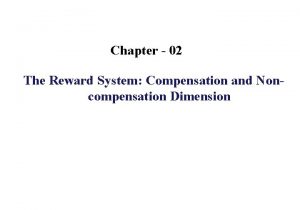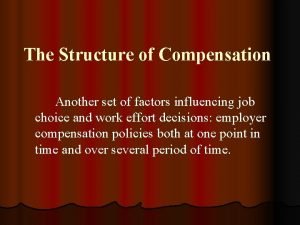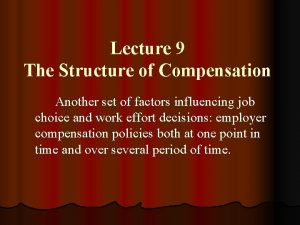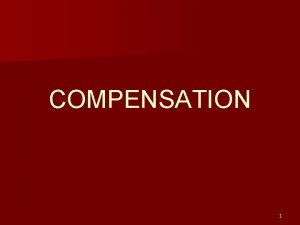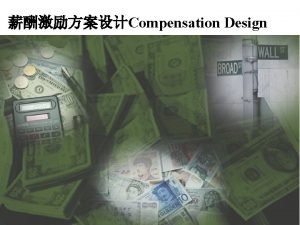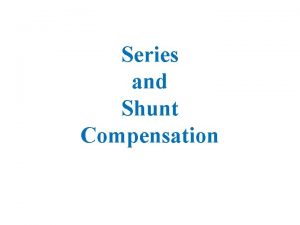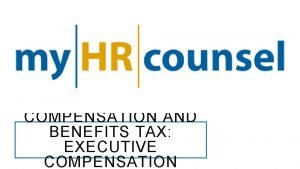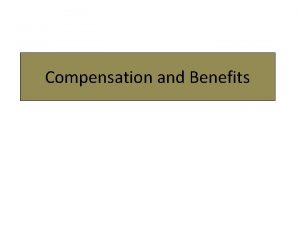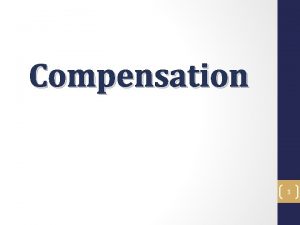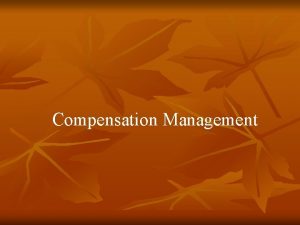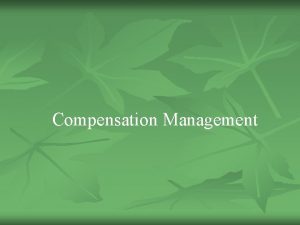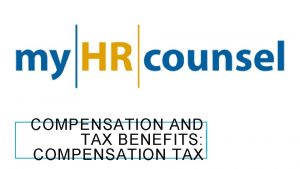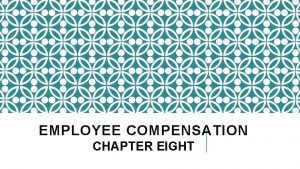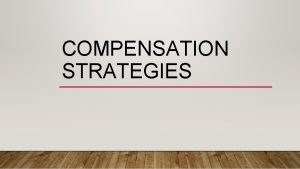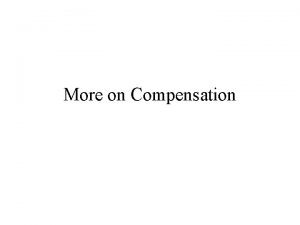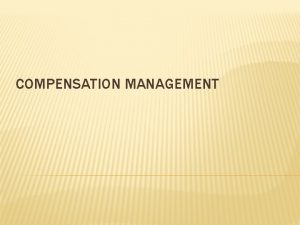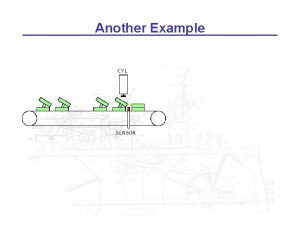The Structure of Compensation Another set of factors






















- Slides: 22

The Structure of Compensation Another set of factors influencing job choice and work effort decisions: employer compensation policies both at one point in time and over several period of time.

1. The Economics of Fringe Benefits 1) Employee Preferences: Two categories of benefits: a) Payment in kind: compensation in the form of some commodity, e. g. , insurance, paid vacation. Other things equal, people would rather receive $X in cash than a commodity that costs $X. However, ‘other things” are not equal. In kind payments offer employees a sizable tax advantage because for the most part, they are not taxable under current income tax regulations.

Deferred compensation: compensation that is earned now but will be paid in the form of money later on. E. g. , pension benefits Deferred compensation schemes enjoy a tax advantage over current cash payments. Because of lower income and special tax advantages given the elderly, the tax rates actually paid are relatively low. Note: With both kinds of benefits there is a loss of discretion in spending one’s total compensation, which tends to render fringes inferior to cash payments in generating utility. On the other hand, the special tax advantage of benefits as compared with cash payments tend to increase the demand for fringe. b)

2) Employer Preferences l Suppose employers are totally indifferent about whether to spend $X on wages or $X on fringes, then the composition of total compensation is a matter of indifference to the employers, only the level of compensation is of concern. l Suppose a firm must pay its workers $X per years to remain competitive in both the labor and the product markets. →The various compensation packages a firm is willing to offer fall along the zero-profit isoprofit curve drawn between wages and fringes.

Wage Rate Employer’s Zero-Profit Isoprofit Curve Nominal Employer Cost of Fringe Benefits The slope of the isoprofit curve is negative reflecting the fact that the firm can increase fringes only if it reduces wages. In this case, the isoprofit curve has a slope of – 1, reflecting employer’s indifference about the composition of compensation. Note: By increasing compensation in the form of fringes rather than wages, employers can often avoid taxes and required insurance payments that are levied as a fraction of payroll. This will make it more costly for an employer to increase compensation by increasing salaries than by increasing benefits.

→A dollar spent on fringes could cost employers more or less than a dollar nominally spent on wages or salaries. When fringes enhance productivity more than a similar expenditure on wages would, the isoprofit curve will flatten. When fringes increase other costs or reduce productivity, the isoprofit curve will be steeper. Wage Rate X A B X Nominal Employer Cost of Fringe Benefits

3) The Joint Determination of Wages and Fringes Wage Rate X Worker Y WY XX traces out the actual offers made by all firms in this labor market. Worker Z WZ FY FZ Nominal Employer Cost X of Fringe Benefits Those employees who attach relatively great importance to the availability of current spendable cash will choose to accept offers in which total compensation comes largely in the form of wages. (such as worker Y) employees who may be less worried about current cash income but more interested in the tax advantages of fringe benefits will accept offers in which fringe benefits form a higher proportion of total compensation. (worker Z)

Note: Because firms that pay high wages usually also offer very good fringe benefits, it often appears to the casual observer that wages and fringes are positively related. Casual observation in this case is misleading because it does not allow for the influences of other factors, such as the demands of the job and the quality of workers involved.

2. Current Status and Future Prospect of Fringe Benefits 1) Current Status There are three major types of benefits provided to employees: a) Paid: vacations, holidays, sick leave maternity leave etc. b) Insurance Plans: medical care, life, disability etc. c) Retirement and Saving Plans: defined benefit pension, profit sharing, employee stock ownership etc. d) Additional Benefits: parking, educational assistance, employee discount etc.

2) Future Prospect Over the past few decades there have been considerable changes in the composition of employee benefits offered to workers. While many of these changes have brought a new philosophy, and a new administration of employee benefits, all indications point to a continual expansion and redefinition of employee benefits packages.

a) Early Retirement Early retirement programs are designed to assist an organization in achieving some measure of cost savings in their direct wage bill. Typically, as employees’ tenure with an organization has grown in years, these employees’ salaries have risen to high levels. To address this concern, and realizing that age discrimination laws may be affected an incentive program to encourage these worker to sever their ties with the organization. →The key issue in early retirement programs is to provide enough incentive for the employee to voluntarily take an early retirement, while simultaneously allowing for the direct wage bill of the organization to be reduced.

b) Parental Leave Parental leave can be defined as any leave from work, paid or unpaid, for employees to attend to child care responsibilities for a newborn infant or newly adopted child. →Although the Family and Medical Leave Bill permits this time off, there is a financial concern: The 9 to 5 organization estimates that fewer than 40 percent of working women would be financially able to take an unpaid leave. →There was an even greater controversy surrounding parental leave-do fathers deserve the same time off as mothers with respect to family leave? Under the Family and Medical Leave Bill passed in 1993, they do!

c) Children and Eldercare Another major trend affecting corporations today is the push for an increase in child- and elder-care benefits. →Dual-career couples with children and/or elderly live-in parents need to have some assurance that child- or eldercare programs are available to them without major disruptions to their lives. →Companies are beginning to recognize that when its employees are faced with a choice between their jobs and their families, the vast majority of employees clearly place their job second. →American Express, IBM, Work Family Directions, and Allstate Insurance have joined forces to offer quality childcare at a facility that is in close proximity to all of their employees. In coming years, we can only expect such cooperative arrangements to continue when they are feasible to both the employer and the employee.

d) Flexible Benefits: A benefit program in which employees are permitted to pick benefits that most meet their needs, within monetary limits imposed. 1. 2. 3. 4. Flexible Spending Accounts. Modular Plans. Core-plus Options Plans. Add-on Plans.

3. The Compensation of Executives There has been a lot of interest in recent years in the salaries of high-level executives, such as chief executive officers, or CEOs. American CEOs have much higher salaries than their counterparts in Germany and Japan. For example, the average salary of the top 20 executives in the United States is $4. 8 million, as compared to $1. 8 million in Germany, and $530, 000 in Japan.





1) The Principal-Agent Problem l The analysis of CEO compensation also raises a number of important questions in economics. In particular, what should be the compensation package of a person who runs the firm, yet does not own it? l The CEO is an agent for the owners of the firm (the owners are also called the principals). The owners of the firm, who are typically the shareholders, want the CEO to conduct the firm’s business in a way that increases their wealth. l The inevitable conflict between the interests of the principals and the interests of the agent is known as the principal-agent problem. The structure of CEO compensation can be interpreted in terms of a tournament where the vicepresidents compete for promotion, and where the winner runs the company. This interpretation explains why the “prize spread” is larger when executives are promoted to CEO than when executives are promoted from junior to middle-level management.

l Suppose there are three levels of management: the CEO, senior vice-presidents, and junior vicepresidents. Junior vice-presidents compete among themselves for promotion to senior vice-president, who in turn compete among themselves for promotion to CEO. Executives who won the firstlevel tournament and were promoted to high-paying jobs as senior vice-presidents may find that the compensation in their current position “meets all their needs, ” and therefore may not want to compete for promotion to CEO. In order to elicit work effort from the senior vice-presidents, the prize associated with becoming a CEO must be even larger than the prize associated with becoming a senior vice-president.

2) The Link between CEO Compensation and Firm Performance l In order to continuously elicit the correct incentive from the person who wins the tournament, the CEO’s compensation will have to be tied to the firm’s economic performance. The CEO would then be restrained from taking actions which reduce shareholder wealth. The empirical evidence indicates that there is indeed a positive correlation between firm performance and CEO compensation, although the elasticity of CEO pay with respect to the rate of return to shareholders is small.
 Noncompensation
Noncompensation Total set awareness set consideration set
Total set awareness set consideration set Training set validation set test set
Training set validation set test set Factors influencing compensation philosophy
Factors influencing compensation philosophy Harris burdick captain tory
Harris burdick captain tory Bounded set vs centered set
Bounded set vs centered set Crisp set vs fuzzy set
Crisp set vs fuzzy set Crisp set vs fuzzy set
Crisp set vs fuzzy set Crisp set vs fuzzy set
Crisp set vs fuzzy set What is the overlap of data set 1 and data set 2?
What is the overlap of data set 1 and data set 2? The function from set a to set b is
The function from set a to set b is What factors most inspired conquistadors to set sail?
What factors most inspired conquistadors to set sail? Situation vs site
Situation vs site Abiotic factors in an ecosystem
Abiotic factors in an ecosystem Abiotic vs biotic factors
Abiotic vs biotic factors Abiotic vs biotic factors
Abiotic vs biotic factors Abiotic vs biotic factors
Abiotic vs biotic factors Site vs. situation
Site vs. situation Greatest common factor powerpoint
Greatest common factor powerpoint Factors of 7
Factors of 7 Factors of 56
Factors of 56 Hình ảnh bộ gõ cơ thể búng tay
Hình ảnh bộ gõ cơ thể búng tay Frameset trong html5
Frameset trong html5
